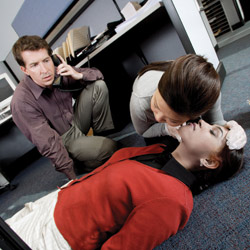
A cardiac emergency can occur anytime, anywhere.
The employees at Caterpillar Inc.’s facilities in East Peoria know this all too well. Two years ago, they witnessed a colleague collapse moments after arriving for second shift. On a March afternoon in 2008, Paul Nackers of Pekin went into cardiac arrest near his cubicle. It was a startling scene.
But because Caterpillar takes the health and safety of its employees seriously, Nackers’ colleagues were equipped to respond. They had been trained by the American Red Cross for just such an incident.
One worker dialed 911, while another woman began cardiopulmonary resuscitation (CPR). Still others grabbed a portable, automated external defibrillator (AED). Meanwhile, building security flagged down employee Chris McGill to administer shocks from the device. Their quick thinking kept their colleague alive until emergency crews arrived.
“We knew we gave him the best opportunity,” McGill later told a reporter. It was a feat of incredible teamwork.
Perhaps what’s most incredible about this story is that it’s not unique. Each year, some 300,000 people suffer sudden cardiac arrest. The vast majority of incidents occur outside of the hospital, in everyday settings: At home. At the store. And, frequently, on the job, where American adults spend more than half of their waking hours.
In January 2009, a similar scene played out near the printing press at the Peoria Journal Star. A mailroom worker had gone out to the parking lot and came back inside, saying he couldn’t breathe. As he began to lose consciousness and slump over, a pair of co-workers rushed to his side to give CPR, thereby keeping oxygenated blood flowing to the man’s vital organs.
They, too, had been trained by the Red Cross.
In such situations, it is not paramedics or doctors who must spring into action, it’s us—average, everyday employees. We must recognize what’s happening and call for emergency responders, then begin CPR until an AED is ready for use. Lay people often are the first link in the cardiac chain of survival.
No matter what type of industry or how big the office, the Red Cross Central Illinois Chapter urges local business to train their employees in First Aid, CPR and AED. Proper training can mean the difference between life and death.
The Red Cross offers several convenient options:
- Instructors can come to the workplace and train employees days, evenings or weekends.
- Businesses can become “authorized providers” and have staff members educated as Red Cross instructors. This option allows employers to schedule training for large groups and to create in-house emergency experts.
- Businesses may enroll employees in two-part, blended learning training. Employees access the first part online, and then follow up with an instructor-led skills practice and assessment.
Furthermore, the Red Cross advises businesses to keep one or more AEDs at their facilities. As with any safety device—fire extinguishers, smoke detectors, sprinkler systems, First Aid kits—AEDs belong anywhere people gather, especially at work.
It just makes sense. Effective CPR, provided immediately after sudden cardiac arrest, can double a victim’s chance of survival. Meanwhile, the American Heart Association notes that more than 20,000 lives could be saved each year with the use of an AED.
Preparing your business also makes cents. Studies from the U.S. Occupational Safety and Health Administration (OSHA) show an average $4-to-$6 return for every dollar invested in workplace health and safety education, with improvements in the costs associated with absenteeism, compensation claims and productivity. Red Cross training is the solution that’s both ethical and economical.
“Training is critical—not just the one time, but repeated at least once a year,” McGill noted after the Caterpillar rescue. “When you’re practicing, you’re doing it on a dummy. When you’re doing it in real life, you might be doing it to someone you’re around all the time.”
Would your employees know what to do if a co-worker, client or customer suffered sudden cardiac arrest? iBi

